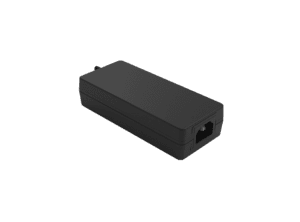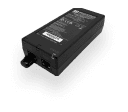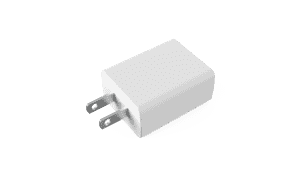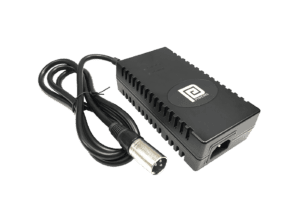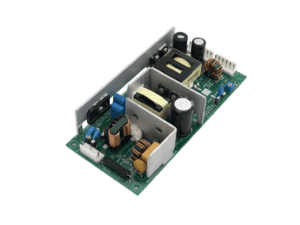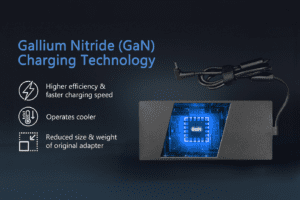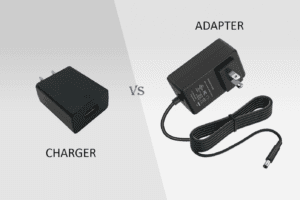BLOG
GaN Charging – Why Are GaN Chargers Better Than Silicon-Based Chargers?
Table of contents

Chargers are an essential part of our lives—whether they’re powering our smartphones, laptops, or electric vehicles. As our gadgets become more sophisticated, their demand for power increases; thus, traditional silicon-based chargers start to show their limitations (if you’re paying attention, that is). But not to worry, big tech is constantly on the cutting edge, finding new ways to meet the growing demands of our power-hungry electronics. From solid-state batteries for EVs to super-efficient materials like Gallium Nitride (GaN) and Power Delivery (PD) for our favorite portable devices, charging technology is advancing in efficiency, compatibility, and safety.
In this article, we will discuss the most popular materials and protocols found in the latest charging adapter equipment and will explain why they are quickly becoming the go-to for tech enthusiasts everywhere.
History of Silicon and GaN Chargers
Silicon-based chargers have been the power supply of choice in the electronics industry for over half a century. Since the 1950s, silicon has been the preferred material for creating semiconductors, the essential components of modern electronics. Its widespread availability and favorable semiconductor properties have made it ideal for use in devices that regulate electrical currents, including chargers.
The history of silicon in power electronics is closely linked to the development of personal computers, mobile phones, and most other electronic devices we use today. For decades, silicon-based chargers were optimized to meet the growing power demands of these devices. However, as electronic gadgets have evolved, with increasing demands for higher power delivery and faster charging, the limitations of silicon have become more apparent. These limitations include its reduced efficiency at handling higher voltages and its tendency to generate excessive heat, resulting in larger, bulkier charger designs.
Gallium Nitride (GaN), discovered in the mid-20th century, initially found its use in specialized applications such as LEDs and high-frequency communication devices. However, it wasn’t until the 1990s that GaN’s potential for power electronics became evident. Its ability to handle higher voltages, switch faster, and operate at higher efficiencies made it an ideal candidate for replacing silicon in power semiconductor applications.
In the early 2000s, research into GaN’s capabilities began to show its potential in consumer electronics, particularly in fast-charging solutions. By the 2010s, GaN chargers started making their way into the electronics market. GaN’s unique properties, such as higher thermal efficiency and faster switching speeds, positioned it as a game-changer for industries requiring compact and efficient power delivery solutions. This breakthrough is what has allowed modern GaN chargers to deliver significantly more power in much smaller packages compared to their silicon counterparts.
Why GaN Chargers Are Superior to Silicon Chargers
1. Heat Management and Efficiency
One of the biggest challenges with silicon-based chargers is dealing with heat. Silicon semiconductors aren’t great at staying cool, especially when the power demands go up. This is why traditional chargers tend to get hot during use, requiring bigger heat sinks and bulkier designs to handle the heat. All that heat doesn’t just make the charger bigger—it can also shorten its lifespan by wearing down the internal components over time.
GaN chargers, however, handle heat much better. GaN semiconductors produce far less heat, even when delivering more power. Because of this, they don’t need large heat sinks, allowing for more compact, lightweight designs. Plus, staying cooler means these chargers last longer, as their internal components face less heat-related wear and tear.
2. Switching Speed and Frequency
GaN chargers really shine when it comes to switching speed compared to their silicon counterparts. But what exactly is switching speed? It refers to how quickly a semiconductor can turn on and off during power conversion. Faster switching means the charger can manage electricity more efficiently.
Silicon devices are typically limited to switching frequencies of just a few hundred kilohertz, while GaN devices can operate at several megahertz or even tens of megahertz. This huge difference in speed allows GaN chargers to use smaller components like capacitors and inductors, which helps keep the charger compact and lightweight. Slower switching in silicon chargers, on the other hand, requires bulkier parts and results in less efficient power delivery, especially in high-voltage applications.
Thanks to their higher switching speeds, GaN semiconductors not only enable more compact designs but also improve overall power conversion efficiency. This allows GaN chargers to deliver more power in less time, making them perfect for fast-charging devices like smartphones, tablets, and laptops.
3. Power Density and Size
Power density refers to the amount of power that can be delivered per unit volume. Silicon-based chargers have a lower power density, meaning they need more space to handle higher power levels. This results in bulkier and heavier chargers, particularly for high-wattage devices like laptops and gaming systems.
GaN chargers, on the other hand, have a much higher power density. This allows them to deliver more power in a smaller form factor. For instance, a GaN charger that can deliver 100 watts of power can be as small as a standard smartphone charger. This high power density is one of the main reasons why GaN chargers are becoming the preferred choice for portable charging solutions, as they are more convenient to carry and use without compromising on performance.
4. Durability and Lifespan
Silicon-based chargers are generally reliable but tend to wear out faster, especially in high-power applications. They generate more heat, which can cause the silicon semiconductors to break down faster over time. This is a bigger concern for high-wattage chargers, like those for laptops or other performance-heavy devices, where managing heat is essential.
On the other hand, GaN chargers are more durable due to their better thermal properties and higher efficiency. GaN semiconductors can handle higher voltages and temperatures without degrading, making them last longer, particularly in environments where chargers are heavily used or need to handle more power.
5. Environmental Impact and Sustainability
The production and use of silicon-based chargers have a larger environmental footprint due to their size, energy inefficiency, and the materials required to manufacture them. Silicon refinement is an energy-intensive process, and the bulkier design of silicon chargers means that more raw materials are used.
GaN chargers, being smaller and more efficient, require fewer raw materials and consume less energy during use. Their higher efficiency also translates to less wasted energy, making them a more environmentally friendly option. As the world moves towards more sustainable technologies, the adoption of GaN chargers aligns with global efforts to reduce energy consumption and minimize the environmental impact of consumer electronics.
6. Price and Cost Efficiency
Silicon chargers have historically been cheaper to produce due to well-established manufacturing processes and economies of scale. This affordability made them the go-to choice for manufacturers producing chargers for mass-market devices.
GaN chargers are initially more expensive due to the relatively new production processes and materials used. However, as GaN technology matures and production scales, the cost of manufacturing GaN chargers has decreased. Today, while GaN chargers may still be slightly more expensive than silicon chargers, their superior performance, smaller size, and longer lifespan often justify the higher price tag, especially for users who prioritize fast charging and portability.
GaN & SiC Technology in EV Charging Solutions
As electric vehicles (EVs) become more prevalent, the demand for advanced charging technologies continues to grow. Two materials at the forefront of this technological shift are Gallium Nitride (GaN) and Silicon Carbide (SiC).
Silicon Carbide (SiC) is a cutting-edge semiconductor material known for its exceptional properties. Unlike traditional silicon-based semiconductors, SiC can handle much higher voltages and temperatures, making it an ideal choice for high-power applications. Its robustness and efficiency in extreme conditions set it apart from other materials.
With the rise of electric vehicles (EVs), there’s a growing need for faster and more efficient charging solutions. GaN technology has already made significant strides in this area by offering high power handling capabilities in a compact form. However, Silicon Carbide (SiC) is also gaining traction in EV charging solutions, particularly due to its superior ability to manage high voltages and temperatures.
SiC transistors, known for their efficiency and durability, are increasingly preferred in high-power applications such as EV fast chargers. They offer enhanced performance under extreme conditions, making them particularly well-suited for public fast-charging stations where reliability and efficiency are crucial. As a result, SiC plays a key role in enabling faster and more reliable charging for EVs, especially in demanding, high-voltage environments.
Comparison of GaN and Silicon Carbide (SiC) in EV Charging
- Power Efficiency: Both GaN and SiC are more efficient than silicon, but SiC generally performs better at very high voltages and power levels, making it a preferred choice for fast-charging stations in EVs. GaN, on the other hand, shines in lower to medium power applications and could potentially reduce the size and cost of on-board EV chargers.
- Thermal Management: SiC is highly effective in handling extreme heat, which is common in EV fast-charging applications. GaN is also better than silicon in terms of thermal management but may not be as robust as SiC at ultra-high power levels.
- Cost: GaN technology is relatively new in EV applications, and while it has the potential to reduce overall system costs due to its smaller form factor and reduced cooling requirements, SiC is currently more established and cost-effective in high-power applications.
- Applications: SiC is widely used in high-voltage DC fast-charging stations, whereas GaN might be more appropriate for on-board chargers or lower-voltage fast chargers, especially in smaller EVs or plug-in hybrids.
In summary, GaN technology could complement SiC in EV charging infrastructure by offering solutions for lighter, more compact charging stations, particularly for in-home or on-board systems. However, SiC will likely remain dominant in high-voltage applications such as public fast-charging networks.
GaN’s Future Forecast in Consumer Usage in the Next 10-20 Years
GaN technology is expected to see significant growth in the consumer electronics market over the next 10-20 years. With increasing demand for more energy-efficient, compact, and high-performance charging solutions, GaN’s advantages are becoming more apparent. As production costs decline due to advancements in manufacturing processes, it is likely that GaN chargers will become the standard for many types of electronic devices.
Predicted Trends for the Next 10-20 Years:
- Widespread Adoption in Smartphones and Laptops: As the technology matures, more smartphones, tablets, and laptops will begin to adopt GaN chargers as standard. Major tech companies have already started including GaN-based chargers in their products, which will likely become a common feature in most consumer electronics.
- Expansion into Automotive and EV Markets: While GaN is currently being explored in EV charging infrastructure, it may find wider applications in on-board EV chargers or smaller electric vehicles like e-bikes and scooters. GaN’s lightweight and compact nature can make it ideal for portable and in-vehicle charging solutions.
- Further Miniaturization: GaN’s efficiency at high frequencies will enable the development of even smaller chargers, with form factors shrinking to the point where high-power chargers may be nearly pocket-sized.
CLIENT'S QUOTE
Phihong's Power-Over-Ethernet solutions have transformed our network, boosting efficiency and reducing costs. Their seamless integration has simplified both installation and maintenance.
Explore More with Phihong USA
As we conclude our exploration of GaN technology, it’s evident how these innovations are streamlining power and connectivity across the tech world. Phihong USA stands at the forefront of this technological advancement, offering a diverse range of power solutions designed to meet the evolving needs of modern industries.
Phihong USA’s extensive product lineup includes:
- Power over Ethernet (PoE) Solutions: Delivering reliable power and data transmission over a single cable, ideal for simplifying network installations and reducing costs.
- AC/DC Adapters and Power Supplies: From compact adapters to industrial-grade power supplies, Phihong provides solutions that ensure efficiency and reliability in various applications.
- Battery Chargers: Customizable chargers for lithium-ion and lead-acid batteries, supporting a wide range of power requirements for mobility and industrial applications.
- Medical Power Supplies: Specialized power solutions designed to meet the stringent requirements of the healthcare industry, ensuring safety and reliability.
Phihong USA is committed to innovation and excellence, continually developing products that meet the highest standards of performance and reliability. Their global reach and dedication to customer support make them a trusted partner in powering the future.
Here are some useful links to explore Phihong USA’s offerings further and bring in new potential clients:
Visit Phihong USA to discover how their advanced power solutions can support your business needs. Whether you’re looking to upgrade your network, or find reliable power supplies, Phihong USA has you covered.
By choosing Phihong USA, you’re partnering with a leader in power technology, ensuring your operations run smoothly and efficiently with top-tier power solutions.

Contact Our Team Today!
Our dedicated sales team and international partners are prepared to support you with your latest projects and initiatives globally.
FAQs
Are GaN chargers more durable than silicon-based chargers?
Yes, GaN chargers are generally more durable than silicon-based chargers due to their better thermal management and efficiency. Since GaN semiconductors produce less heat, they are less prone to the wear and tear that results from overheating. Silicon-based chargers, particularly those handling high power, tend to degrade faster as they generate more heat, which can lead to the breakdown of internal components over time. GaN chargers, by contrast, can operate at higher voltages and temperatures without significant degradation, making them more reliable and long-lasting, especially in demanding environments where chargers are heavily used.
Will GaN chargers become more affordable in the future?
While GaN chargers are currently more expensive than traditional silicon-based chargers due to the newer technology and production processes, their cost is expected to decrease over time. As GaN technology becomes more widely adopted and production scales up, the manufacturing costs are likely to decline, making these chargers more affordable for the average consumer. Already, the price gap between GaN and silicon chargers is narrowing, and the superior performance, compact size, and longer lifespan of GaN chargers often justify their higher price tag. As demand for faster, more efficient charging solutions continues to grow, GaN chargers are likely to become the standard, driving down costs even further.
What is the environmental impact of using GaN chargers?
GaN chargers are more environmentally friendly than traditional silicon-based chargers due to their smaller size, energy efficiency, and reduced material usage. GaN technology allows for more compact chargers, which means fewer raw materials are needed to produce them. Additionally, their higher efficiency results in less energy wasted during charging, contributing to lower energy consumption overall. Silicon refinement is an energy-intensive process, and the larger, bulkier designs of silicon chargers require more resources to manufacture. As the world moves towards more sustainable technologies, GaN chargers represent a step forward in reducing the environmental footprint of consumer electronics.

